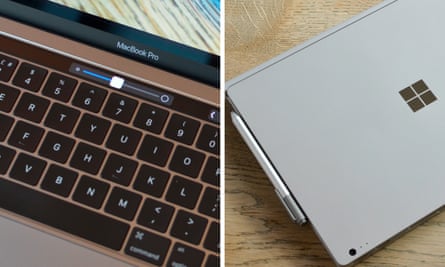I am a musician and software developer who wants to get into live coding and electronica using software like Sonic Pi and maybe, in the future, Max/MSP from Cycling 74. Most people seem to use Apple’s MacBook Pros, but I have always been a Windows user, and develop software on Windows using Visual Studio, so I am reluctant to switch to a Mac. However, every time I have tried to get a good music-making setup on Windows, I have been beset by latency problems. From what I have read online, it seems the Windows audio drivers, though improved with Windows 10, are still way behind those on MacOS.
I have a Roland Duo-Capture EX and an older Novation X-Station, and I am happy to use one of these as part of my set-up, but I would like a system that is sufficiently portable to make performing with it straightforward.
Finally, a touch screen would make a lot of sense for less code-based interactions – ideally one where the screen can be laid flat, such as the Lenovo Yoga series or Microsoft Surface Pro. Miles
Your best bet would be to find and cultivate some of the people who compose and/or perform using Windows laptops – there are some! – and ask for advice. Areas like this usually involve tacit knowledge that you only learn by doing stuff for some time, and I have not done it at all.
The Guardian’s product and service reviews are independent and are in no way influenced by any advertiser or commercial initiative. We will earn a commission from the retailer if you buy something through an affiliate link. Learn more.
Failing that, there are probably some websites or online communities that specialise in this topic. I didn’t find any, but people who are heavily involved in the field will know where they are. It’s another question that readers may be able to answer in the comments below …
However, perhaps you should think about your overall strategy. As I understand it, you want to do everything on one laptop, which could mean taking your work machine into hazardous nightclub-style environments. This gives you the worst of both worlds.
Laptops are not the best choice for sustained work such as coding, because they have poor ergonomics. You should be using a desktop – which will run faster and last longer for less money – with an ergonomic keyboard and a big screen. For the price of a MacBook Pro with a suitable specification, you could probably buy a desktop PC for programming and a second-hand MacBook for performances.
Using a desktop PC would enable you to add a suitable soundcard and avoid most if not all of the Windows driver problems by using kernel streaming, or Steinberg’s ASIO (Audio Stream Input/Output) as supplied with some devices, or ASIO4ALL. Of course, you could also replace your old Roland with an external USB sound card. This should provide better audio quality with a laptop, as well as – I hope – reduce the risk of latency problems.
Sonic Pi to the Max
Sam Aaron’s open source Sonic Pi program was written for the Raspberry Pi, so any PC or Mac ought to be able to run it well enough. It’s a very simple system where you specify a note just by typing a number, but it becomes very powerful when the “note” is a sample. It reminds me of the Logo language where you can loop simple instructions to create attractive patterns. I bet Terry Riley would have loved it.
Max/MSP (Max Signal Processing, and/or Miller Smith Puckette) from Cycling 74, which is now owned by Ableton, is a different kettle of bouillabaisse. It’s a visual programming language where you can connect objects (program routines) together to create giant data-flow diagrams.
Cycling 74’s website recommends an Intel Core i5 or faster processor and 8GB or more memory for running Max 8, which “includes MSP, Jitter, Gen and support for Max for Live”. (Interestingly, the “ASIO-compatible sound card recommended for optimum audio performance” with Max 6 has been dropped.)
Most DAWs (digital audio workstation programs) really require 16GB of RAM, and some work best with 32GB (Pro Tools). However, Max 8’s Jitter graphics seem to be the main challenge, and Cycling 74’s helpful user forum has at least one example of someone running Max on a tiny 4GB Core m3-based Intel Compute Stick.
Possible options

You haven’t mentioned a budget, but the best value MacBook option at the moment is the 13-inch MacBook Pro with a seventh-generation 2.3GHz Core i5, 8GB of memory and either 128GB (£1,249) or 256GB (£1,449) of SSD storage. A system with 16GB of memory and a 256GB SSD would therefore cost £1,629. Adding three years of AppleCare – a good idea in view of previous keyboard failures – bumps that up to £1,878.
One of the major problems with current MacBook Pros is that you can’t upgrade them: you have to buy everything you will need at the beginning, and pay Apple prices. If you buy a Windows laptop, you can choose one with more configuration options that you can also upgrade later.
My current pick is the 14in Lenovo ThinkPad T480S with an eighth-generation 3.4GHz Core i5-8250U processor. A basic system with 8GB of memory, a 128GB SSD, Windows 10 and three years of carry-in service would cost £1,189.99. Expanding that to 16GB of memory and a 256GB SSD pushes the price up to £1,279.59, but there are many more options. In fact, you have a choice of four processors, going up to a Core i7-8650U, four RAM capacities going up to 24GB, four sizes of SSD going up to 1TB, and four different displays, going up to WQHD (2560 x 1440 pixels). If you want a touch screen, that’s an extra £46.80.
One option I would definitely take is to upgrade the warranty to three years of on-site service for an extra £63.60. Lenovo offers up to five years on-site service for £225.60.
There’s also a slightly cheaper, slightly larger version, the ThinkPad T480, which starts at £949.99. This offers even more options. It has a traditional 2.5in drive bay – the base model has a 500GB hard drive – so you can have two drives. It also has two memory slots instead of one, so you can have up to 32GB of memory. These are real advantages when you can take the back off and upgrade parts later.
The T480 and T480S do not have 360-degree hinges to work as tablets, but they do rotate to 180 degrees, so you can lie them flat.
The Lenovo Yoga range is not built or tested to the same standards as the ThinkPad T range, but then, prices start at £199.99. However, the top-of-the-range Yoga 920, currently on offer at £999, only has 8GB of memory and it isn’t expandable.
Microsoft’s Surface Pro 6 only lets you have 16GB of memory if you buy a 512GB SSD and a Core i7, which comes to £1,723.99 including Type Cover keyboard. That would be silly.
Latency tests
You can check a PC for latency problems by running Resplendence’s Latency Monitor for at least 15 minutes. This can help you identify what’s causing problems, though running SiSoftware’s Sandra Lite will provide more helpful advice for optimising your system.
However, the fact is that Windows is a general-purpose program, not a real-time operating system. Leave it running long enough and it will eventually find something that, for a few milliseconds, is more important than delivering your audio bits. You can reduce the odds by not running other software, stopping non-essential background tasks, disconnecting from networks and so on, but you can’t eliminate the risk entirely.
How much any transient glitches matter is another question. Only you can decide.
Have you got a question? Email it to Ask.Jack@theguardian.com
This article was updated on 11 January to correct an error that stated the ThinkPad T480 had a 3.5in instead of a 2.5in drive bay

Comments (…)
Sign in or create your Guardian account to join the discussion